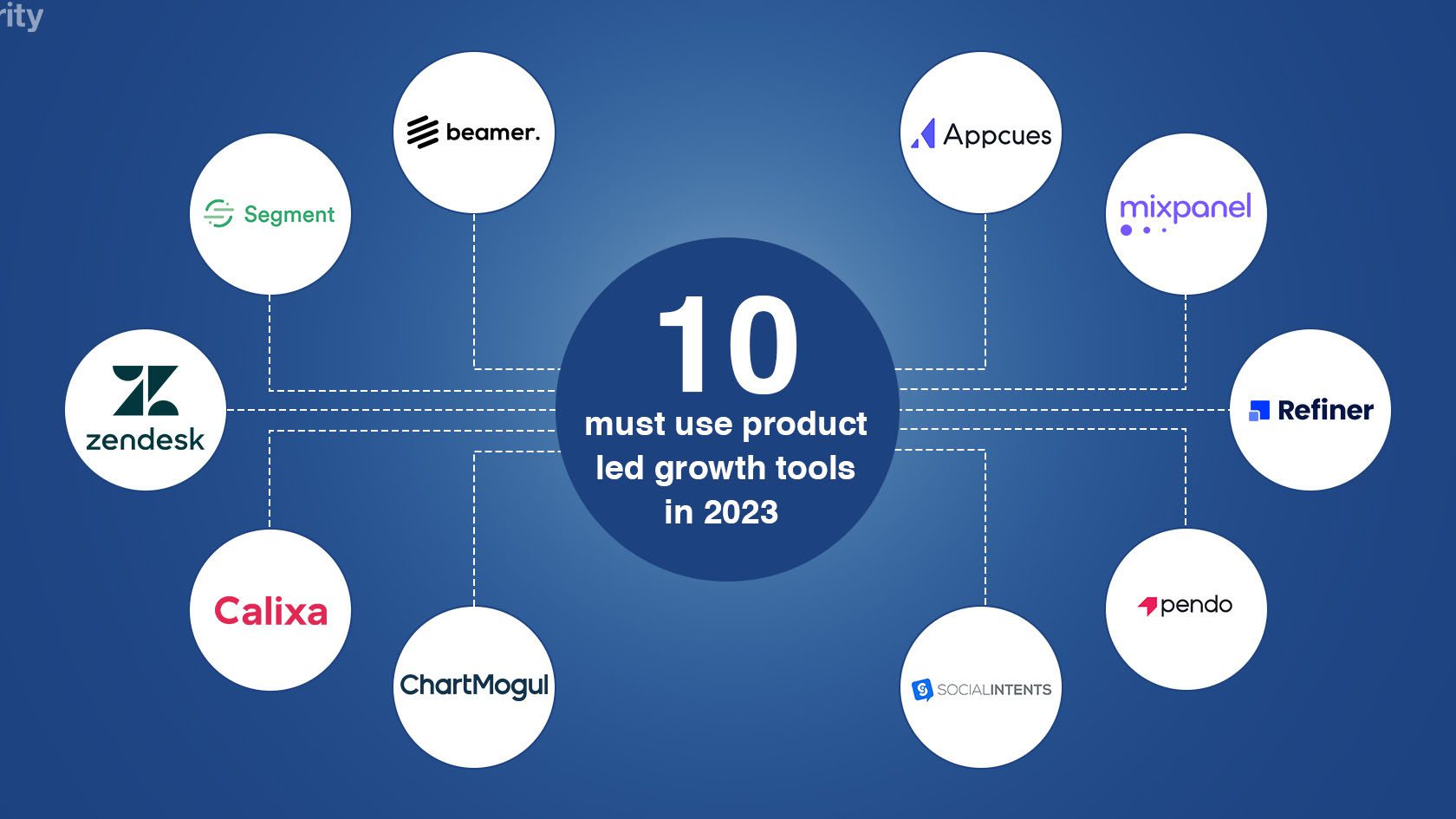Introduction
Businesses must adapt the way they create business plans to reflect how markets are changing to reflect public interests and objectives. Currently, it appears like every tech business is enthusiastic about product-led growth. A product-led growth approach is increasingly popular way to satisfy picky customers, but it only works when used carefully. When a product-led growth strategy is effectively implemented, the product itself becomes the primary driver of growth, freeing up team members to concentrate on the customer. If you’re a user of a successful product-led growth product, it’s unlikely that you learned about it through a cold call. Before you started using the product, you might not have even heard of it. This category of products grows by word-of-mouth and social virality, not through conventional marketing and sales channels.
Austin Belcak, Founder Cultivated Culture, tweets on the emphasis of Product led growth approach for marketing their SaaS tools
Product led growth is the future of marketing Barrett.
We used the same strategy with our SaaS tools. We initially offered them for free which created a ton of SEO traffic. We leveraged free users for feedback and product improvement. Then we added in a layer of monetization!
— Austin Belcak (@austinbelcak) May 11, 2022
Product-led growth (PLG) entails optimizing your product so that it can generate self-service sales, provide consumers with rapid value, and persuade them to switch from being freemium or trial users to paying customers. To be successful, your PLG technology stack must make it simple to collect quantitative and qualitative product usage data so that you and your teams are always aware of what’s happening with the product and where the best growth possibilities are. Product-led growth tools offer start-ups and other businesses the kind of scalable functionality they need to add value as they grow. Your business can more quickly carve out its own niche in the market by understanding these tools and the product-led strategy in general.
Are you developing a product-led growth strategy for your business? Are you unsure of which product-led growth tools to employ? There is no better approach to building a SaaS business than by leveraging the product as the primary driver. You’ll need some specialized tools, though, to effectively implement a product-led growth strategy. However, it can be confusing to know which choices to make when there are so many available. This blog post discusses the top 10 must-use product-led growth tools in 2023 that businesses need to adopt in order to aid in their product-led growth journey.
Before getting started with a list of product-led growth tools, let us look at what product-led growth is.
Table of Contents
What is product-led growth?
Product-driven growth is not merely a passing fad; it is the future of global business. And that future has here. Instead of relying on sales tactics or marketing magic to steer expansion, making the product the focal point of your business allows all of your employees, regardless of role or specialty, to work together as one unified unit based on the real product being offered to customers.
This growth strategy employs the product itself as the most effective bargaining tool for acquiring long-term client loyalty and dependable revenue over time. Product-let growth strategy highlights the importance of answering the questions of why people should buy your product and how they will find out about it. Rather than depending solely on exclusivity, this strategy utilizes the power of a superior user experience to attract more users and increase sales. The experience people enjoy with your product should result in its quick spread via word of mouth, producing a strong snowball effect. To ensure the success of your strategy, product-led growth tools must be selected as early as feasible during the product’s design process.
Why do you need product-led growth tools?
Getting individuals to test your product is insufficient. After they have signed up, you must ensure that they have a positive user experience and recognize the value of your product. You may be wondering, “Why do I even need a product-led growth tool?”
There are a few scenarios in which you might require one:
- Product-led growth tools let businesses create automated in-app tutorials like welcome screens, checklists, and tooltips without wasting your developer’s time on specialized coding.
- PLG tools offer product usage metrics that enable you to identify the consumers that require assistance and when.
- PLG tools allow businesses to target in-app experiences more precisely with segmentation (something that would be impossible to achieve if all in-app instructions had to be coded by hand).
- PLG tools enable businesses to automate the process of implementing and A/B testing multiple product-led strategies faster.
Astasia Myers, Founding Partner at Quiet Capital, tweets about the importance of adopting PLG tools for business.
Leveraging product-led growth #PLG means adopting the right GTM tools. Traditional #CRMs don’t cut it because they aren’t product usage/journey-oriented. Reverse #ETL tries to help pipe product usage data into legacy systems to solve for PLG. Teams deserve a better #PLG CRM.
— Astasia Myers (@AstasiaMyers) April 13, 2021
Must-have characteristics of product-led growth tools
Prior to settling on a product-led growth tool, it’s important to bear in mind a standard set of capabilities that should be present in every viable option. If not, you won’t be able to effectively create in-app guides, product tours, and more that assist businesses in creating effective users experience value.
Consider these criteria when selecting a product-led growth tool:
Setup clear objective
Start by establishing specific objectives. What do you hope to accomplish with each tool? Each product should contribute in some way to the PLG strategy. If it is not part of your strategy, you are employing it for the sake of it.
User interface
Ensure that the tool you use does not restrict access to fundamental UI patterns and guidelines on the beginner plans. Checklists, modal design, tooltips, banners, and hotspots are the most significant for executing a product-driven strategy.
Collaborate on common tools
It’s easy to slip into the trap of having separate teams use different tools. Whether teams work in silos or you haven’t looked at a tool’s features, it’s easy to end up paying for more than one tool that does the same thing. Stop overcomplicating your company processes. Bring together all teams to determine the most effective tools for everyone.
Balanced tool stack
You should be able to maintain a balanced tool stack over the entire lifecycle. You shouldn’t employ too many tools during the onboarding phase and forget about engagement or conversion. Ensure that the tools you use facilitate both your work and the user experience for your consumers.
Customer Segmentation
Consider acquiring segmentation capabilities based on in-app behavior and interaction with in-app experiences so that you can customize your messaging for each segment.
Niche tool usage
If you’re serious about scaling your SaaS business with your PLG approach, you should employ niche tools. If you’re just getting started, all-in-one tools can be useful, but they don’t necessarily give the same degree of experience and functionality in every area that you focus on. Even better, seek technologies designed specifically for SaaS enterprises. There are a variety of features available on SaaS-focused applications that can make your work more effective.
Advanced analytics
Adequate analytics will be helpful. Look for a tool that gives you at least basic capabilities to gather and evaluate the feedback and that enables you to track how users progress through the user journey and interact with the product’s features.
Integration capabilities
The ideal tool should be able to integrate with other tools in your stack, allowing you to gain superior insights into your data in a single location.
Top 10 product led growth tools in 2023
Looking to accelerate product growth but unsure which tools deliver the best cost-effectiveness? Here are the ones you should be considering.
Social Intents
Social Intents is probably the perfect fit for your business if your team needs a better way to communicate with customers across a variety of collaborative platforms. Social Intents is a live chat platform that can enhance your customer support. This product-let growth tool enables businesses to communicate with website visitors straight from Microsoft Teams, Slack, and Webex to increase communication and responsiveness.
Pendo
Pendo is a product experience platform that helps various software teams determine to track how often customers are using or interacting with various features and software components. Insights like this can be used to tailor in-app tutorials, notifications, and walkthroughs to each individual user’s needs. Customers’ web and mobile app behavior can be analyzed with the use of Pendo’s platform data.
Businesses can benefit from Pendo’s behavioral analytics platform by extracting and analyzing information like time spent, trends over time, and drop-off points. By having this information on hand, businesses will be better able to tailor their content to the needs of a certain audience and make adjustments in light of the findings. Pendo gives tools to send feedback surveys and polls, allowing businesses to gather both qualitative and quantitative data to learn where their customers are experiencing issues so they can fix them
Refiner
Refiner is a survey tool designed specifically for data-driven SaaS companies. Using this platform, businesses may design mini survey widgets to collect data for use in customer segmentation, satisfaction tracking, and product planning for SaaS enterprises. You can utilize the platform to ask people questions as they interact with your product.
By using Refiner, businesses can personalize their surveys with features like branded colors, translation support, and data visualization. Product managers can test out their surveys before releasing them to customers, ensuring consistency with the brand and readability. You can also receive notifications when client’s complete surveys and configure triggers to contact them based on their responses.
Mixpanel
Mixpanel is a well-known product analytics tool that can help you with your PLG approach. Mixpanel is a freemium product analytics software for monitoring mobile and web application performance. Its interactive reports assist you in gaining a better understanding of your users and how they utilize your product, hence increasing your engagement, conversion, and retention rates.
Mixpanel helps businesses keep track of important quantitative data such as LTV (customer lifetime value) and churn rate, analyze user click activity across the product to determine what is being overlooked, create funnels to show how free users become premium users, segment data to identify retention drivers and more
Appcues
Appcues is an excellent addition to your PLG stack for enhancing the user experience of your product. Appcues is a high-end user onboarding and product adoption solution for developing in-app product tours and onboarding flows. It facilitates the development of individualized product experiences that enhance user activation, feature uptake, and user retention.
Appcues delivers contextualized experiences to the appropriate users, helps create streamlined processes for onboarding new customers to speed up their time, notify users of relevant new features to enhance adoption, gathers feedback and insights to help you enhance your product. and more
Chartmogul
ChartMogul is a subscription analytics tool that enables you to track, comprehend, and expand your revenue. It facilitates data-driven decision-making by automating the reporting of critical SaaS KPIs such as monthly recurring revenue, annual recurring revenue, churn rate, and lifetime value. Its integration capabilities with your existing technology and data stack can facilitate data management and analysis easier. ChartMogul can Segment data to identify user profiles and price options that are likely to result in conversions.
Calixa
Calixa is a platform that provides businesses with insights into how their customers use their products. Incorporating this data into their conversion optimization strategy will allow businesses to interact better with customers at key points in their journey. The platform can provide real-time alerts whenever a customer takes a predefined action or reaches a certain parameter, allowing you to interact immediately with the consumer.
Calixa enables you to view your consumers’ actions and interactions while using your product. You may view payments, events, emails, and other actions to determine how to conduct productive talks. When you receive a qualified lead, the platform can minimize the time it takes to gain the finest insights and take action.
Zendesk
With Zendesk, you have access to four separate products, each of which, when coupled with a product-led growth approach, can accelerate the growth rate of your business. Zendesk addresses important customer service challenges such as conversational assistance alternatives and real omnichannel capabilities.
Zendesk allows you to continue interactions across several channels, including social media, email, phone calls, and live chats. Having a built-in knowledge base and discussion board makes this a potent PR tool for your staff.
Beamer
Beamer is ideal for those who want to streamline their announcement management in whatever manner possible. Beamer is a product marketing tool that allows consumers to receive product updates, messages, and notifications.
Beamer’s primary function is to send notifications, which it does in a variety of easy-to-use forms and which may be displayed directly within your app. Beamer can handle the implementation details to speed things up, whether your team wants to display pop-ups at strategic times or announce new advancements in a stylish top bar. Beamer also facilitates the creation of dynamic changelogs, which may be used to monitor the evolution of your product and keep your audience up to date.
You may start meaningful conversations with the people you serve by sending out surveys, and Beamer provides a robust answer to this problem in the form of NPS. The best part is that your team won’t need to write any code at all to speed things up. There’s potential for user participation in the product’s evolution via roadmaps as well. Beamer delivers in this regard by providing a novel roadmap and feature request system, both of which can aid your team in selecting the most fruitful objectives by analyzing and responding to user feedback.[
Segment
Segment is a prominent customer data platform that collects events from websites and mobile applications in order to help you manage and analyze customer data. By consolidating customer data across channels and devices into a unified profile and by providing insights into product performance through A/B testing, this tool helps businesses better serve their clientele. Customer interactions can be tailored to each individual and occur in real-time; the code is well-organized and simple to use.
In conclusion
From the discussion above, it should be clear that there are various advantages to employing product-led growth tools for your business. You must ensure that your technology stack contains the appropriate tool in order to deliver outstanding product-driven growth. It is not enough to know about the best tools for product-led growth; you also need to put them to use in order to develop your product.
The above list offers ten of the top product-led growth tools that may help you increase your customer base and lead generation with the help of your product. When selecting the ideal tool for your SAAS application, keep in mind that it should improve your customer’s experience so that they will not hesitate to join up after their free trial.
Utilizing product-led growth as a growth strategy necessitates navigating a rapidly changing landscape of threats and consumer interests. Having access to expert guidance can provide your team with the advantage required to maintain market share. Our team at Sparity can assist you in transforming relative uncertainty into a short- and long-term profitable plan. Contact us to schedule a call and find out how we can help bring your digital product to life.















